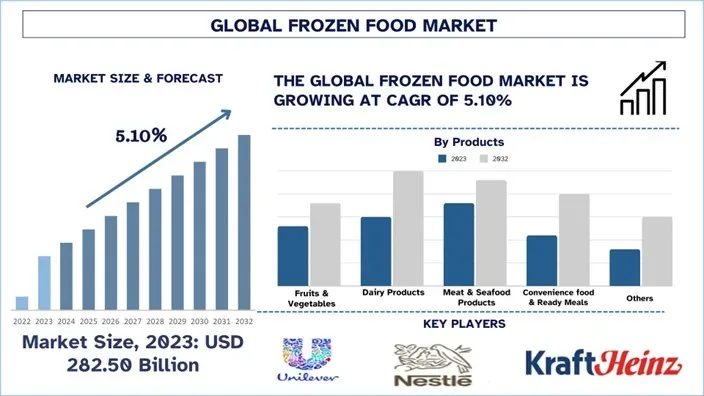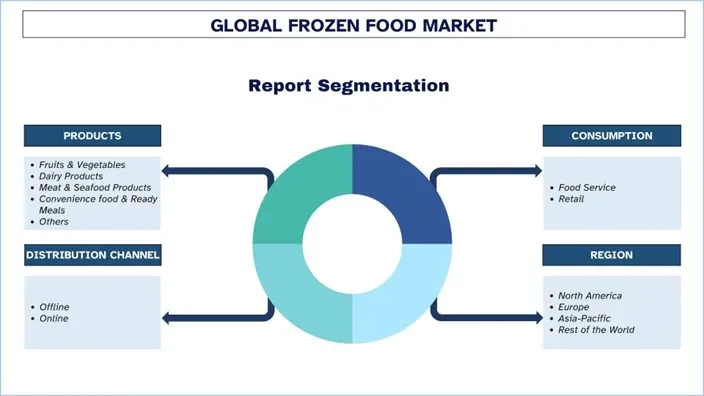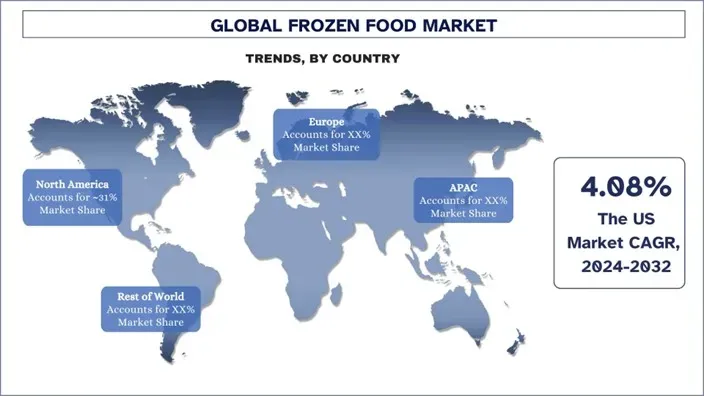- Home
- About Us
- Industry
- Services
- Reading
- Contact Us
Frozen Food Market: Current Analysis and Forecast (2024-2032)
Emphasis on Products (Fruits & Vegetables, Dairy Products, Meat & Seafood Products, Convenience food & Ready Meals, and Others); Consumption (Food Service and Retail); Distribution Channel (Offline and Online); and Region/Country

Frozen Food Market Size & Forecast
The frozen food market was valued at USD 282.50 billion in 2023 and is expected to grow at a robust CAGR of around 5.10% during the forecast period (2024-2032), owing to the growing demand for convenience foods and time-saving, along with the rising urbanization and economic growth.
Frozen Food Market Analysis
The frozen food market has emerged rapidly in the last couple of years due to rising urbanization and economic growth. Increased urbanization and economic growth are key factors that expand the frozen food industry, affecting multiple processes and consumer behavior. People moving to cities and towns in search of better lifestyles, health considerations, and time constraints have led to a reduction in the practice of kitchen cooking. Further, moving from home kitchens to outside facilities and with the growing disposable income in developing nations, there is a rise in the need for convenience as far as food is concerned, which the production of ready-to-eat foods meets. Urbanization also results in an enhanced infrastructure for cold chains and new and better store formats, thus making frozen foods available to a broader group of consumers. This trend is further fast-paced due to the increased number of supermarkets and hypermarkets in emerging markets. Besides, with economic growth, there emerges a group of middle class that requires diversified types of meals, including international ones, which are met with frozen foods. The combination of these conditions is beneficial for the frozen food market, forcing companies to develop new products and logistics models to fit the needs of the growing urban population who prefer ready-made meals but do not want to compromise on quality and taste.
Recent instances and developments highlighting this trend include:
In April 2023, Carrier Transicold launched the Supra eCool truck refrigeration series. The new Supra eCool electric units will cover 14- to 28-foot, Class 5 to 7 straight trucks. These trucks are designed for regulatory compliance or simply cleaner, more sustainable options to deliver frozen foods across the industry. The enhanced cold chain facility drives the frozen food market.
In February 2023, DHL Global Forwarding expanded its U.S temperature-controlled warehouse network with an investment of USD 8 million. The company is opening a new 40,000-square-foot warehouse to meet industry demand.

Frozen Food Market Trends
This section discusses the key market trends influencing the various segments of the frozen food market as identified by our research experts.
Innovative Packaging Solutions
Innovative Packaging Solutions are another important trend in Global Frozen Food, where they respond to top benchmark concerns and industry difficulties. This trend is about creating packs that offer product protection, freshness, increased shelf life, convenience, and respect for the environment.
In August 2023, a leading frozen food firm launched self-heating packs for ready-to-eat meals, which allow consumers to warm food even without using a microwave. For this product range, the firm got a 15% sales uplift.
In October 2023, a major packager introduced nano-barrier packaging technology that increases frozen food shelf life by 40% and decreases freezer burn occurrences by 60%.
These innovations reflect the industry's adaptation to evolving consumer preferences for healthier frozen food options.
Frozen Food Industry Segmentation
This section provides an analysis of the key trends in each segment of the global frozen food market report, along with forecasts at the global, regional, and country levels for 2024-2032
The Dairy Products Market Dominates the Frozen Food Market
Based on the products category, the market is segmented into fruits & vegetables, dairy products, meat & seafood products, convenience food & ready meals, and others. Among these, the dairy products market occupies the largest market share in the frozen food market by producing frozen dairy products, including ice cream as well as frozen yogurt and butter, and cheese. Consumers make more frozen dairy product choices because these items offer longer durability, together with ease of use, plus multitudinous flavor varieties. Plant-based frozen dairy products with lactose-free features continue to increase market demand along with their rising popularity. Freezing technology improvements allow for preserving dairy product texture and nutritional value, thus keeping this segment active in propelling frozen food industry growth.
The Food Service Market Dominates the Frozen Food Market
Based on the consumption category, the market is bifurcated into food service and retail. Among these, the food service market occupies the largest market share in the frozen food market. Food service operations like fast-food restaurants, hotels, and catering businesses push frozen food sales across the world. Organizations use frozen food items because they offer dependable results along with longer durability and faster cooking times. The growing need for quick restaurant meals and expanded internet food delivery services makes restaurants use more frozen food products. The worldwide growth of food service businesses will maintain the need for frozen food as their most economical production solution.
North America Dominates the Frozen Food Market
North America's frozen food market currently dominates and is expected to dominate in the forecasted period. The frozen food industry in North America, primarily in the United States and Canada, is growing at a fast pace due to innovations in technology and changing customer trends. The market is supported by advanced freezers that freeze items to a better quality and packaging that makes the items easily accessible. Some of the leading companies in the industry include ConAgra Foods, General Mills, and Kraft Heinz, and while these players are diversifying their product portfolios to meet the new trends, the frozen food industry is characterized by intense competition. Also, the expansion of e-commerce has enabled a wider market for frozen foods and better cold chain technologies. Additionally, there is growing awareness of healthy living, and this is putting pressure on the manufacturers to provide better quality frozen foods that are organic, hence extending the market. For instance, in June 2023, ConAgra Foods released its new line of organic frozen meals based on the increasing focus on healthier foods in the frozen food market. These products are designed to meet consumer expectations by solving mealtime dilemmas and satisfying cravings.
The U.S. Dominates the North American Frozen Food Market
The U.S. frozen food industry grows rapidly thanks to changing consumer habits and convenience improvements, plus the latest freezing methods. People with busy lives now prefer purchasing frozen food products because they need convenient, ready-made meals and treats. People are now more aware of leftover food prevention methods, and better transportation networks are accelerating market growth. The market for frozen foods will keep expanding because of maturing plant-based and healthy product development.

Frozen Food Industry Overview
The frozen food market is competitive and concentrated, with few global and international players. The key players are adopting different growth strategies to enhance their market presence, such as partnerships, agreements, collaborations, new product launches, geographical expansions, and mergers and acquisitions. Some major players operating in the market are Unilever, Nestle, The Kraft Heinz Company, General Mills Inc., Cargill, Incorporated, Ajinomoto Co., Inc., WK Kellogg Co., Conagra Brands, Inc., Tyson Foods, Inc., and FRoSTA AG.
Recent Developments in the Frozen Food Market
In 2024, Nestlé India signed a strategic collaboration agreement with restaurant SOCIAL and BOSS Burger to experiment with MAGGI Professional’s plant-based products.
In 2023, Konscious Foods introduced the first in a line of plant-based frozen ‘raw’ seafood in Whole Foods. They are the first to offer fully frozen sushi, nigiri, and poke bowls, among others.
In March 2024, Campbell Soup Company, a US-based fast-moving consumer goods company that deals in flagship canned soup products, acquired Sovos Brands, Inc. for an amount of USD 2.7 billion. The acquisition strengthens Campbell’s product portfolio and its presence in the market. With the help of this acquisition, the company has added a range of products frozen entrées, frozen pizza, and yogurts, under the brand names Rao’s, Michael Angelo’s, and Noosa.
In November 2023, Tyson Foods, a US-based company specializing in food processing and the world’s second-largest processor of chicken, beef, and pork after JBS S.A., invested USD 300 million fully cooked food production facility in Danville, Virginia. The investment increased the production capacity of the company and met the growing demand for frozen protein-rich foods.
Frozen Food Market Report Coverage
Details | |
Base year | 2023 |
Forecast period | 2024-2032 |
Growth momentum | Accelerate at a CAGR of 5.10% |
Market size 2023 | USD 282.50 billion |
Regional analysis | North America, Europe, APAC, Rest of the World |
Major contributing region | North America dominated the market in 2023 |
Key countries covered | The US, Canada, Germany, The UK, France, Italy, Spain, China, Japan, and India |
Companies profiled | Unilever, Nestle, The Kraft Heinz Company, General Mills Inc., Cargill, Incorporated, Ajinomoto Co., Inc., WK Kellogg Co., Conagra Brands, Inc., Tyson Foods, Inc., and FRoSTA AG. |
Report Scope | Market Trends, Drivers, and Restraints; Revenue Estimation and Forecast; Segmentation Analysis; Demand and Supply Side Analysis; Competitive Landscape; Company Profiling |
Segments Covered | By Products, By Consumption, By Distribution Channel, and By Region/Country |
Reasons to Buy the Frozen Food Market Report:
The study includes market sizing and forecasting analysis validated by authenticated key industry experts.
The report presents a quick review of overall industry performance at a glance.
The report covers an in-depth analysis of prominent industry peers with a primary focus on key business financials, product portfolios, expansion strategies, and recent developments.
Detailed examination of drivers, restraints, key trends, and opportunities prevailing in the industry.
The study comprehensively covers the market across different segments.
Deep dive regional-level analysis of the industry.
Customization Options:
The global frozen food market can further be customized as per the requirements or any other market segment. Besides this, UnivDatos understands that you may have your own business needs; hence, feel free to contact us to get a report that completely suits your requirements.
Table of Content
Research Methodology for the Frozen Food Market Analysis (2024-2032)
We analyzed the historical market, estimated the current market, and forecasted the future market of the global Frozen Food market to assess its application in major regions worldwide. We conducted exhaustive secondary research to gather historical market data and estimate the current market size. To validate these insights, we carefully reviewed numerous findings and assumptions. Additionally, we conducted in-depth primary interviews with industry experts across the Frozen Food value chain. After validating market figures through these interviews, we used both top-down and bottom-up approaches to forecast the overall market size. We then employed market breakdown and data triangulation methods to estimate and analyze the market size of industry segments and sub-segments.
Market Engineering
We employed the data triangulation technique to finalize the overall market estimation and derive precise statistical numbers for each segment and sub-segment of the global Frozen Food market. We split the data into several segments and sub-segments by analyzing various parameters and trends, including product, consumption, distribution channel, and regions within the global Frozen Food market.
The main objective of the Global Frozen Food Market Study
The study identifies current and future trends in the global Frozen Food market, providing strategic insights for investors. It highlights regional market attractiveness, enabling industry participants to tap into untapped markets and gain a first-mover advantage. Other quantitative goals of the studies include:
Market Size Analysis: Assess the current and forecast market size of the global Frozen Food market and its segments in terms of value (USD).
Frozen Food Market Segmentation: Segments in the study include areas of product, consumption, distribution channel, and regions.
Regulatory Framework & Value Chain Analysis: Examine the regulatory framework, value chain, customer behavior, and competitive landscape of the Frozen Food industry.
Regional Analysis: Conduct detailed regional analysis for key areas such as Asia Pacific, Europe, North America, and the Rest of the World.
Company Profiles & Growth Strategies: Company profiles of the Frozen Food market and the growth strategies adopted by the market players to sustain in the fast-growing market.
Frequently Asked Questions FAQs
Q1. What is the current size and growth potential of the frozen food market?
The global frozen food market was valued at USD 282.50 billion in 2023 and is projected to grow at a CAGR of 5.10% from 2024 to 2032. The market is expanding due to increasing demand for convenient, ready-to-eat meals and advancements in freezing technology and cold chain logistics.
Q2. Which product segment holds the largest share in the frozen food market?
The dairy products segment currently dominates the frozen food market due to high consumer demand for frozen cheese, butter, yogurt, and milk-based desserts. The increasing adoption of plant-based dairy alternatives is also driving growth in this category.
Q3. What factors are driving the growth of the frozen food market?
- Rising demand for convenience foods due to busy lifestyles.
- Advancements in freezing technology that improve food quality and shelf life.
- Increased focus on healthier frozen food options, including organic and plant-based products.
- Expansion of e-commerce and online grocery delivery services, making frozen foods more accessible.
Q4. What are the latest technologies and trends in the frozen food industry?
- Smart packaging solutions, including biodegradable and vacuum-sealed packaging, to extend product freshness.
- Adoption of Individual Quick Freezing (IQF) technology to preserve food texture and nutrients.
- AI and IoT integration in cold chain management for improved storage and distribution efficiency.
- Growing demand for clean-label and preservative-free frozen foods to meet consumer health preferences.
Q5. What are the key challenges in the frozen food market?
- Dependence on cold chain infrastructure: Maintaining consistent temperature control across supply chains is critical.
- High energy costs: The storage and transportation of frozen foods require significant energy consumption.
- Regulatory compliance: Strict food safety and labeling regulations vary across regions.
- Consumer perception: Some consumers still associate frozen foods with lower quality compared to fresh alternatives.
Q6. Which region is expected to lead the frozen food market?
North America is projected to dominate the global frozen food market
Q7. Who are the key players in the frozen food market?
Leading companies in the frozen food industry include:
- Unilever
- Nestlé
- The Kraft Heinz Company
- General Mills Inc.
- Cargill, Incorporated
- Ajinomoto Co., Inc.
- WK Kellogg Co
- Conagra Brands, Inc.
- Tyson Foods, Inc.
- FRoSTA AG
Q8. What are the top investment opportunities in the frozen food industry?
Expansion of cold chain logistics to enhance supply chain efficiency.
Development of plant-based and organic frozen food products to cater to health-conscious consumers.
Integration of AI and automation in frozen food processing to improve quality and reduce waste.
Strategic partnerships with e-commerce platforms to drive online frozen food sales.
Q9. How can frozen food manufacturers improve sustainability and meet regulatory standards?
Adopting eco-friendly packaging materials to reduce plastic waste.
Using energy-efficient freezing and refrigeration technologies to lower carbon emissions.
Ensuring compliance with international food safety regulations, including HACCP, FDA, and EU standards.
Enhancing transparency in ingredient sourcing and labeling to build consumer trust.
Related Reports
Customers who bought this item also bought










